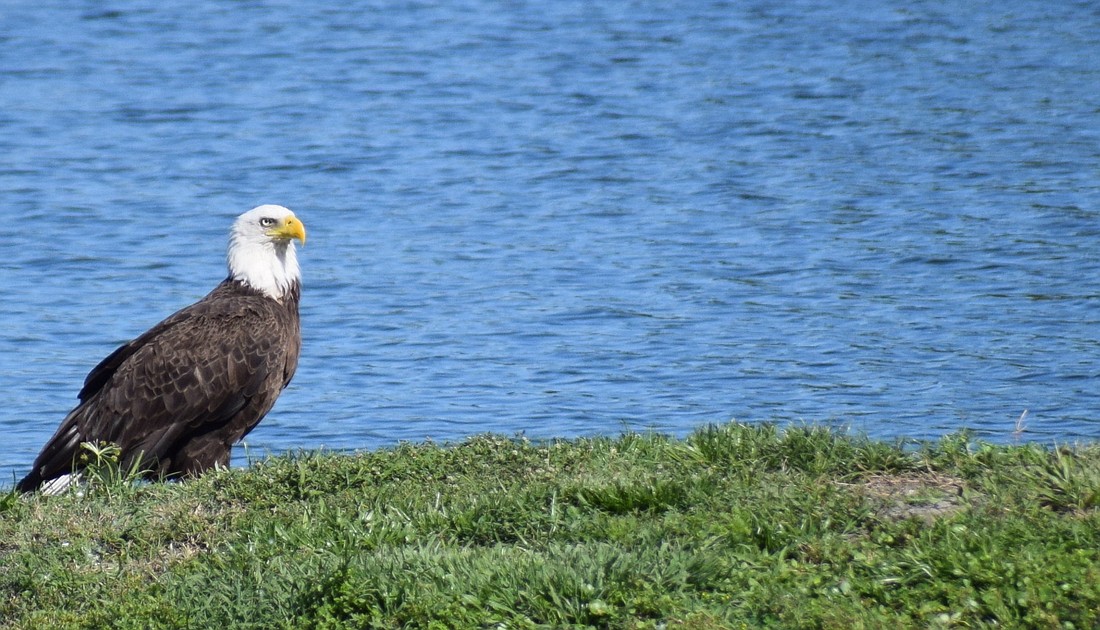- December 26, 2024
-
-
Loading

Loading

In speaking with friends from outside Florida, University Park's Susan Beausang often mentions she had just come back from photographing bald eagles.
"They are amazed to hear I can go out and photograph a bald eagle here in Florida," Beausang said.
Surprise, indeed, Florida ranks third in the U.S. with its more than 1,500 nesting pairs (study by AZAnimals.com) of bald eagles behind only Alaska, which boasts more than 30,000 bald eagles, and Wisconsin, which has an estimated 1,600 nesting pairs.
Beausang, a member of the Lakewood Ranch Digital Photography Club, takes advantage of the many bald eagle nests in the Sarasota and Manatee counties region to photograph the majestic bird. She especially likes watching nests on White Eagle Boulevard in Lakewood Ranch, at the Manatee County landfill site in East County, and on Lido Key Beach in Sarasota.
"White Eagle really is the best because it is so open there," Beausang said. "And it's such a fun thing because you can watch the ongoing story. Fall is nest building where they are bringing sticks and whatnot. Then it is mating in late December before the babies come in January and February. You can see four to five months of activity and some people are there faithfully every day."
As the region celebrates the July 4 holiday, it can be tough to enjoy the national bird because most of the bald eagles fly north for the summer. However, some breeding bald eagles choose to remain year round and that gives more opportunities to capture one of our country's most recognized symbols in flight.
"Watching the bald eagle, it's no wonder it is our country's symbol of freedom," said Margaret Lanier, who is a member of the Lakewood Ranch Digital Photography Club and a Florida Audubon Eagle Watch volunteer. "When I see a bald eagle flying, my eyes are drawn to its size, strength, agility, and how free it looks. Like the birds, Americans are strong, love where they live, and protect it. But mostly, we are free like the eagles."
As an Eagle Watch volunteer, Lanier watches a nest on Tuttle Avenue and one on U.S. 301, both in Manatee County. She records significant moments and documents them with photographs. Like Beausang, Lanier said she loves watching the bald eagles go through their seasonal tasks of rebuilding a nest, mating and raising the eaglets.
"The camera allows me to get in close and share what I see," she said.
Sarasota's Rick Waid said the fact the bald eagle has been America's national bird since 1782 does make photographing it that much more special.
"It's a symbol of our country, and of bravery," Waid said. "It's a bird of prey, and intelligent. I've grown up with it. Eagles are dramatic, huge, acrobatic."
He loves the bonds they form.
"You can see the attraction between them," he said. "I was watching a mated pair the other day and it almost looked like they were kissing."
Waid likes the White Eagle Boulevard nest as a place to shoot, and he likes that the mating pair there seem to keep coming back to the same nest every year. He also shoots photos of bald eagles in Longboat Key just off Gulf of Mexico Drive at Triton Bend.
He said the nest on Longboat Key is in "somebody's backyard in a pine tree, but visible from the road in front of the house because the nest was so high."
Getting those dramatic shots of the bald eagles can be tough.
"Believe me, they can sit on a perch for hours on end and do nothing," Beausang said.
Sarasota's Jane Lyons, who moved to the area five years ago from New York City, knows that patience is rewarded when it comes to photographing bald eagles, but that's OK because she has made visiting a nest on Lido Key Beach in Sarasota part of her everyday walk down the beach. She said the bald eagles seem like part of her family now.
"I know them and can identify them by their expressions," she said. "I can tell them apart when they fly. Every day gives me more insight."
She has gained respect for bald eagles after watching them be caring parents, and she has grieved with them the past two years when their chicks have died, possibly due to poisoning from the adults bringing home rodents that have eaten rat poison.
Jeanne Dubi, president of Sarasota Audubon chapter, said that is a problem in the region that area residents can solve by not using poisons that can kill bald eagles. But it is each individual's decision, so it has been a struggle.
As much as Lyons loves visiting the bald eagles, she said she hopes at times they don't return to the nest because of the potential for having their chicks poisoned.
"To see the parents grieving, it's been an emotional rollercoaster the last two years," she said.
The Florida Fish and Wildlife Conservation Commission does have a state code to protect bald eagles. In part, it says, "No person shall take, feed, disturb, possess, sell, purchase or barter any bald eagle or parts thereof, or their nests or eggs, or attempt to engage in any such conduct."
Those who photograph the majestic bird are just glad it is no longer rare to see one.
Lyons is just happy they chose the bald eagle as the national bird.
"They were going to choose a turkey," she said.